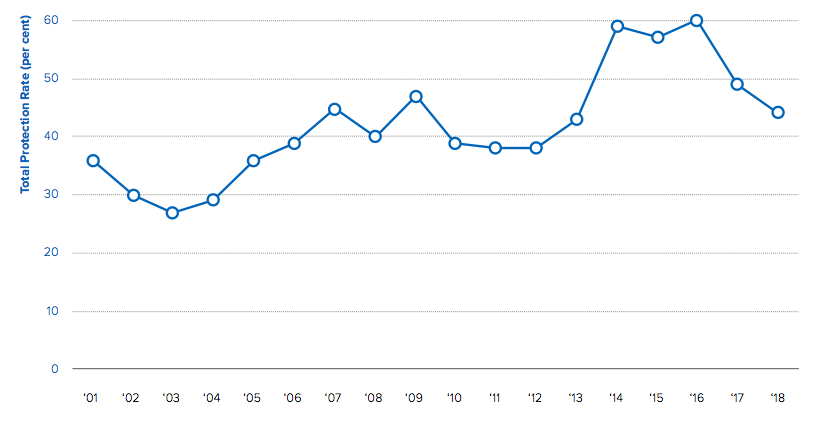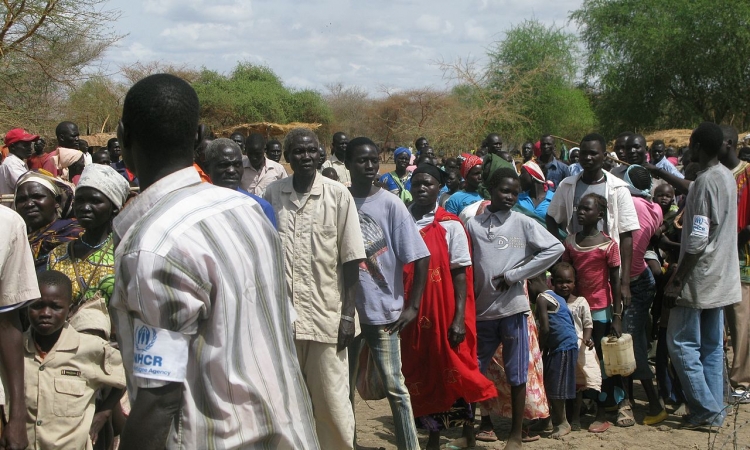Typically, refugee status determinations or asylum adjudications are conducted by an official from a designated government department or agency. These officials should have a solid knowledge of refugee law. In most cases, the official will interview the asylum seeker to evaluate his or her evidence and credibility. The burden is on the asylum seeker to prove that he or she meets the definition of a refugee and asylum seekers are encouraged to supply as much supporting evidence as possible. Supporting evidence may take the form of country reports, NGO reports, news articles, affidavits, or the in-person testimony of witnesses.
In accordance with Article 31 of the 1951 Convention, States parties provide in their domestic law that an applicant’s irregular entry (i.e., without an entry visa or other documentation) will not have a negative effect on the asylum seeker’s application. See, e.g., Refugees Act (2014) Cap. 173 § 11(3) (Kenya). Some States, however, do place time restraints on how many days after entry into their country an asylum seeker may make an application. Compare 8 U.S.C. § 1158(a)(2)(B) (U.S.) (imposing a one-year filing deadline on asylum applications, although there are some limited exceptions for extraordinary or changed circumstances) with National Refugee Proclamation, No. 409/2004, art. 13 (Eth.) (stating that asylum applicants shall apply within fifteen days of entry into Ethiopia). In addition to making a claim at the border, individuals in deportation proceedings may also raise an asylum claim, provided their claim is timely.
Substantive decisions take (2014-2018)

If the official finds that the asylum seeker has a well-founded fear of persecution based on one of the five grounds, he or she can grant the applicant asylum. Individuals granted asylum receive a residence permit for themselves as well as one for any dependent relatives. See, e.g., The Immigration and Refugee Protection Act, S.C. 2001, ch. 27, art. 95(1)(a) (Can.); 8 U.S.C. § 1158(b)(3)(A) (U.S.). States provide that where the Government denies an asylum application, the asylum seeker is to receive an explanation of the reasons for the denial. See, e.g., Refugees Act (2014) Cap. 173 § 11(6) (Kenya). Asylum seekers have a right to appeal their negative decision. Generally, an applicant may not be removed unless they have exhausted all of their available remedies. See CESEDA, L731-3 (Fr.); but see, Human Rights Watch, France: Amend Immigration Bill to Protect Asylum Seekers (noting that under French law appeal does not suspend expulsion for those placed in the fast-track procedure).
Individuals who are ineligible for asylum may nonetheless be eligible for more limited forms of protection. These include protection under Article 3 of the Convention against Torture, which forbids States parties from extraditing or returning an individual to a country where they risk being tortured or subjected to cruel, inhuman, or degrading treatment or punishment. States also grant complementary forms of protection, such as withholding of removal, subsidiary protection, and Temporary Protected Status to individuals who do not meet the definition of a refugee but whose life or freedom would be in danger if returned to their country of nationality or country of habitual residence. 8 U.S.C. § 1254, 1231(b)(3) (U.S.); C.E.S.D.A. L712-1 (Fr.).
Decisions on asylum are made by a contributing number of factors. However guidance can be found under the 1951 Geneva Convention and they state that decisions are made for the following reasons:
- The person would be at risk of experiencing such persecution in the future if they were returned
- The harmful treatment the person fears amounts to ‘persecution’
- The person’s fear of such persecution is ‘well-founded’
- The persecution is for one of the five reasons specified in the Convention
- The person could not find protection in another part of their country
If the application is rejected, the seeker has a right to submit a second claim.
An asylum procedure where an asylum applicant lodges an application for international protection, can result in different decisions, positive or negative, at the different stages of the procedure.
Asylum decisions can be distinguished according to the stage in the procedure when they are taken:
- First instance decision means a decision granted by the respective authority acting as a first instance of the administrative/judicial asylum procedure in the receiving country.
- Final decision means a decision on whether the third-country national or stateless person be granted refugee or subsidiary protection status by virtue of Directive 2011/95/EU and which is no longer subject to a remedy within the framework of Chapter V of this Directive, irrespective of whether such remedy has the effect of allowing applicants to remain in the Member States concerned pending its outcome. The asylum procedures and the numbers/levels of decision making bodies differ between Member States. The true 'final instance' may be, according to the national legislation and administrative procedures, a decision of the highest national court. However, it is not intended that these statistics should cover rare or exceptional cases determined by the highest courts. Thus, the statistics related to the 'final decisions' should refer to decisions against which there is no further possibility to appeal on the substance of the decision but only on procedural grounds.
For the purpose of the Asylum data collection the concepts of first instance decision and final decision include also data on decisions granting or rejecting 'Humanitarian status' under national law concerning international protection.
Depending on the outcome of the decisions, asylum applicants can be categorised in different groups:
- Person being a subject of a pending application means a person who is the subject of an application for international protection under consideration by the responsible national authority at the end of the reference period. It includes the number of persons with pending applications at all instances of the administrative and/or judicial procedure.
- Person granted refugee status means a person covered by a decision granting refugee status, taken by administrative or judicial bodies during the reference period. Refugee status means status as defined in Art.2(e) of Directive 2011/95/EU within the meaning of Art.1 of the Geneva Convention relating to the Status of Refugees of 28 July 1951, as amended by the New York Protocol of 31 January 1967.
- Person granted subsidiary protection status means a person covered by a decision granting subsidiary protection status, taken by administrative or judicial bodies during the reference period. Subsidiary protection status means status as defined in Art.2(g) of Directive 2011/95/EU. According to Art.2(f) of Directive 2011/95/EU a person eligible for subsidiary protection means a third-country national or a stateless person who does not qualify as a refugee but in respect of whom substantial grounds have been shown for believing that the person concerned, if returned to his or her country of origin, or in the case of a stateless person, to his or her country of former habitual residence, would face a real risk of suffering serious harm as defined in Article 15, and to whom Article 17(1) and (2) does not apply, and is unable, or, owing to such risk, unwilling to avail himself or herself of the protection of that country.
- Person granted authorisation to stay for humanitarian reasons means a person covered by a decision granting authorisation to stay for humanitarian reasons under national law concerning international protection, taken by administrative or judicial bodies during the reference period. It includes persons who are not eligible for international protection as currently defined in the first stage legal instruments, but are nonetheless protected against removal under the obligations that are imposed on all Member States by international refugee or human rights instruments or on the basis of principles flowing from such instruments. Examples of such categories include persons who are not removable on ill health grounds and unaccompanied minors.
- Person granted temporary protection means a person covered by a decision granting temporary protection as defined in Art.2(a) of Council Directive 2001/55/EC i.e. 'a procedure of exceptional character to provide, in the event of a mass influx or imminent mass influx of displaced persons from third countries who are unable to return to their country of origin, immediate and temporary protection to such persons, in particular if there is also a risk that the asylum system will be unable to process this influx without adverse effects for its efficient operation, in the interests of the persons concerned and other persons requesting protection'.
- Rejected applicant means a person covered by a decision rejecting an application for international protection, including decisions considering applications as inadmissible or as unfounded and decisions under priority and accelerated procedures, taken by administrative or judicial bodies during the reference period.
Provisional figures indicate that States and UNHCR rendered 1,134,200 decisions on individual asylum applications – new, on appeal, or repeat – during 2018, a decrease from the high seen in 2016.76 These figures do not include cases closed for administrative reasons with no decision issued to applicants, of which 514,900 were reported in 2018.
Global Total Protection Rates (2001-2018)

Of the total substantive decisions taken, UNHCR staff globally adjudicated 67,500 or 6 per cent, a decrease from the 87,400 reported in 2017 but with the proportion of all decisions remaining the same. The decrease is mainly linked to the handover of refugee status determination to national authorities, a decrease in refugee status determination for resettlement purposes and backlog clearance projects. Data relating to individual decisions are incomplete, however, as a few States have not yet released all of their official statistics. Thus, there are likely to be additional substantive decisions that have been taken by States in 2018, figures on which will be updated later.
Available data indicate that 500,100 asylum-seekers were granted protection in 2018, with 351,100 recognized as refugees and 149,000 granted a complementary form of protection. This was the lowest figure since 2013. About 634,100 claims were rejected on substantive grounds, a number that includes negative decisions at the first instance and on appeal. Asylum-seekers rejected at both first and appeal instances may be reported twice, depending on the methods used by governments for reporting decisions on individual asylum applications.
At the global level (UNHCR and State asylum procedures combined), the Total Protection Rate (TPR) was 44 per cent – i.e. the percentage of substantive decisions that resulted in any form of international protection [figure 19].78 This rate is lower than the previous year when it stood at 49 per cent and substantially lower than the 60 per cent reported in 2016 (although at this time global rates are indicative). Looking at the global figures for the countries of origin with over 10,000 substantive decisions, nationals of Burkina Faso had the highest TPR with 86 per cent, followed by nationals of DRC (83 per cent), Eritrea (81 per cent), Syria (81 per cent) and Somalia (73 per cent). Venezuelans received protection in under half of decisions (40 per cent) as did Iraqis (46 per cent), while Afghans received protection in just over half (54 per cent). The TPR varies greatly among countries of asylum. For example, Switzerland had a TPR of 75 per cent, compared with Australia and Sweden where only about a quarter of asylum decisions granted protection (27 per cent and 23 per cent respectively). Germany made the most substantive decisions (245,700) and had a TPR of 43 per cent.
SOURCES: UNHCR, IOM
IMAGE CREDIT: Wikimedia Commons / DFID - UK Department for International Development [CC BY-SA 2.0 (https://creativecommons.org/licenses/by-sa/2.0)]
